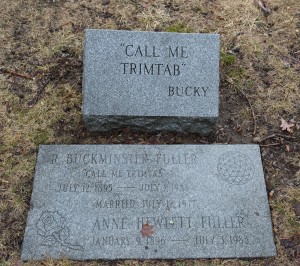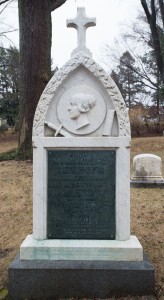

On a filthy March afternoon, a group gathered at Mt. Auburn Cemetery in Cambridge to look at the Cemetery’s restoration of monuments to Civil War dead. One could not pick a more gloomy day to look at the stones of men who’d died violently in their prime.
But, there was much to discover about our times as well.
***
Our second – and, due to rain and chill, last – stop was at a handsome monument to Arthur Buckminster Fuller. Fuller had died at Fredericksburg, Virginia, on December 11, 1862.
Fuller, an ardent Unitarian minister, had served the 16th Massachusetts Regiment of volunteers as a chaplain. His term of service had ended on December 10th, but he’d remained in camp because of an impending battle.
The following morning, he volunteered to take up a rifle for the assault on Fredericksburg. He died at 41 leaving a widow and four children.
Spend enough time in greater Boston and you’ll learn about some very brave, self-sacrificing Unitarians: Civil Rights workers in Alabama and Mississippi; medics in the World Wars; and abolitionists and soldiers in the Civil War.
Arthur Buckminster Fuller was one, but one of many
***
That middle name…. I circled behind the marble monument and found two unpretentious granite stones, one noting the presence of R. Buckminster Fuller (1895-1983) and his wife. The second repeated a line from the first, but attributed it: “‘Call me Trimtab’ – Bucky”
Since a geodesic dome in outline graced his name, this had to be the resting place of the man who shaped architecture, urban planning and ecological thought. But what did the Moby Dick-like quotation mean?
A search of the web led me to this quotation (in several places) but never with an ultimate source:
Something hit me very hard once, thinking about what one little man could do. Think of the Queen Mary — the whole ship goes by and then comes the rudder. And there’s a tiny thing at the edge of the rudder called a trimtab.
It’s a miniature rudder. Just moving the little trim tab builds a low pressure that pulls the rudder around. Takes almost no effort at all. So I said that the little individual can be a trimtab.
Society thinks it’s going right by you, that it’s left you altogether. But if you’re doing dynamic things mentally, the fact is that you can just put your foot out like that and the whole big ship of state is going to go.
So I said, call me Trimtab.
Bucky Fuller was Arthur’s grandson in more than just name. But perhaps in his musings on rudders and ocean liners, there was another, more personal dimension, a wish he could alter a tragic past.
***
Damp and cold, we moved down a slope toward the road leading back to the Bigelow Chapel. I looked back toward Arthur Buckminster Fuller’s stone. Just below it was a somewhat larger stone with a bronze plaque.
It recalled Arthur’s sister, Margaret Fuller, who died, returning from Europe, with her husband and young son in a shipwreck off Fire Island, New York, in 1850. She was just 40 years old.
The Margaret Fuller Bicentennial website, which the Unitarians sponsored in part, modestly summarizes her significance:
Today we consider Margaret Fuller one of the guiding lights of the first-wave of feminism. She helped educate the women of her day by leading a series of Conversations in which women were empowered to read, think and discuss important issues….
Among her accomplishments:
• First American to write a book about equality for women [Woman in the Nineteenth Century]
• First editor of The Dial, [the] foremost Transcendentalist journal, appointed by Ralph Waldo Emerson
• First woman to enter Harvard Library to pursue research
• First woman journalist on Horace Greeley’s New York Daily Tribune
• First woman literary critic who also set literary standards
• First woman foreign correspondent and war correspondent to serve under combat conditions [paragraphing and punctuation altered]
And so much more!
Margaret Fuller’s importance – actual and symbolic – to how we live today, to our concepts of equality and social justice, to how women and men work together, can’t be overstated.
The inscription on her memorial at Mt. Auburn, I think, best captures her spirit. It dates to 1854, long before her legacy was realised.
By birth a child of New England
By adoption a citizen of Rome
By genius belonging to the world
In youth
An insatiate student seeking the highest culture
In riper years
Teacher, writer, critic of literature and art
In maturer age
Companion and helper of many
Earnest reformer in America and Europe
***
Something else caught my attention as I researched this post.
The event that catalyzed Margaret Fuller’s future was the death of her father, US Rep. Timothy Fuller, in 1835, from cholera. At 25 she had to become the breadwinner for a family in very straitened circumstances. Her brother, Arthur, had just entered his teens.
Eleven years later, Arthur’s wife, Elizabeth, also died of cholera. In 1859 he married Emma Reeves. Her son, Richard Buckminster Fuller, was just 22 months old when his father died at Fredericksburg. He died on his namesake’s 15th birthday in 1910.
Bacterial diseases spread by fecal contamination of water supplies; shipwrecks; deaths at early ages; the Civil War. None of those fit my image – or imaginings – of Bucky Fuller. He seemed to embody progress, the future. So he did.
But the future comes with a past.
H/T: The staff at Mt. Auburn and the restorers who worked on the Civil War graves project for a fascinating two hours on March 30.
Recent Comments